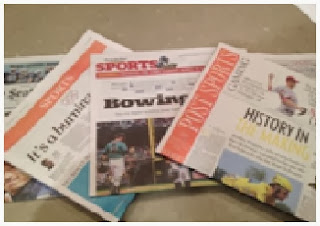Women
in the Media
The
role of women in sport, and indeed society, has changed, but there is still a
long way to go! International Women’s Day is celebrated on the 8th
of March every year and Sport for Women Day is celebrated in the last week of
February every year. The fact that we need to have a day and a week dedicated
to women shows that the role of women is largely undervalued. I want to discuss
the difference between the way that male and female athletes are treated and
portrayed.
Women
are more often than not steered towards individual activities such as
gymnastics, dance and figure skating, where men commonly participate in
aggressive, competitive, physically demanding team sports such as football (Giuliano,
Popp and Knight, 2000). The type of coverage also differs greatly for females
when compared to that of males in terms of descriptors used and language (Kane
1988). Specific descriptors used when talking about athletes vary greatly
between genders. Female athletes are commonly referred to by their first names,
which presents them as soft and girly, whereas men are identified by their last
name, which makes them sound more powerful and imposing.
Language
used also makes perceptions of an athlete’s physical ability differ, depending
on the words chosen to represent an action. For example, a male athlete would
‘miss-fire’ when taking a shot in basketball whereas a female would just miss.
Similarly, if a male were to ‘crash’ against the defence of a tackle, a female
would simply ‘move against’ it. Another fault of the type of media coverage
female athletes receive is that of task relevance. Achievements are often
downplayed, or omitted, which would suggest that the sporting accomplishments
of female athletes are of little importance. This issue is further escalated
with the addition of images to print media. Images that are chosen to accompany
articles are usually very sexualised images, most often with very little to do
with the sport itself, and rather just about the attractiveness of the athlete
( Giuliano, Popp and Knight, 2000). Images of men are most commonly ones taken
during a game, portraying the courageous and strong side to the male, when
compared to women’s imagery in the print media is more of the glamour shots,
posed to be raunchy rather than action shots. Another discrepancy between male
and female athletes in the print media is the display of emotions (Duncan,
1990). Pictures of female athletes crying after a loss or an injury are
regularly seen, whereas when a male is seen crying it is seen as a sign of
weakness, and he is taunted or called ‘a big girl’. When being talked about in
print media, a female may have been ‘crying with disappointment’, whereas a
male would only ‘shed a tear’.
And what is lacking in quality is certainly not made up for
in quantity. Whilst studies report that there has been an increase of female
newspaper coverage by 500% from the late 1980’s, when you look further into the
issue, the figures have risen from a mere 2% of newspaper coverage to 10.8%
(Wensing and Bruce, 2003). Disgusting when you think that horse racing alone
makes up more percentage of the coverage than all female athletes. So how do we
expect to have aspiring Olympic and international female athletes, when they
are given no coverage at all, and the ones that are get portrayed in another
light?
In research I completed in Canada and America in 2013, I
collected information from Canada’s ‘National Post’, ‘The Seattle Times’, and
‘The Denver Post’, all during the Olympics. Data collected included number of
male, impartial and female articles, size and location of all articles, the use
of images, and key language and descriptors in each article. Results were
significant, but not surprising. As can be seen in the graph below, women’s
articles made up 5.26%, 6.6% and 7.41% respectively of all sports articles in
the newspapers. The Denver Post, which contained the most female articles, with
4, places one article on the back page, 2 more on the page back from that and
the last a page from that, making the article the closest article to the front
of the section appearing on the 6th page. These articles are all
located on the side or the bottom of the page, with the largest being a quarter
of the page at most. 3 of the 4 articles contain pictures, the first a colour
picture of gymnast Jordan Wieber crying, the second a colour picture of swimmer
Missy Franklin diving in the start of her backstroke semi final and the third a
black and white picture of swimmer Dana Vollmer celebrating her world record.
None of the photos from any of the newspapers contain any competitors and only
one of the photos contain the sport actually being performed.
There is a massive culture change required in society for
female athletes to be able to feel comfortable in the sporting arena, and this
has to come soon. Why should females be treated any differently to male
athletes? Why do we need to have ‘male’ and ‘female’ defined sports? Shouldn’t
anyone be able to play any sport they like without being judged and criticised?
I am sick and tired of females being under represented and treated unfairly in
the sporting arena, when you cannot chose your gender, but these women are out
there giving 100%. It is time for things to change!




No comments:
Post a Comment